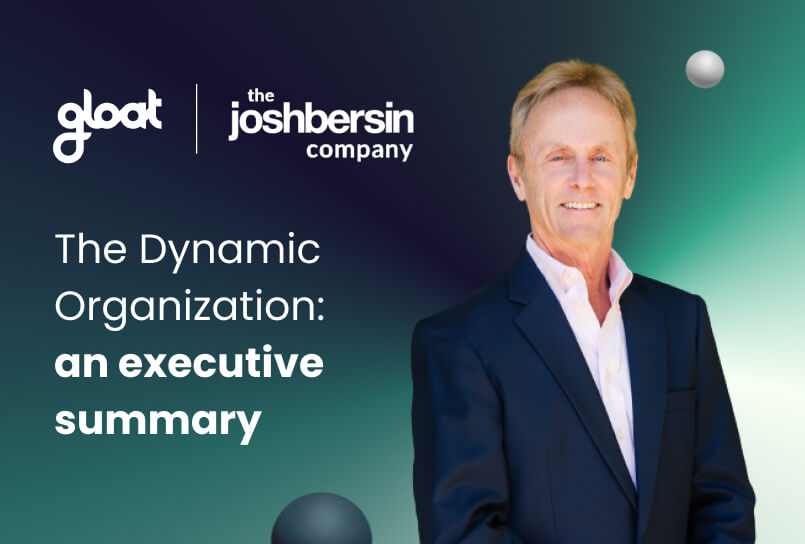What is a skill meritocracy?
Find out what this term means—and why it’s essential to achieving success in 2024

By now, many HR leaders have skills-based transformations on their radar. In fact, 90% of organizations are already experimenting with skills strategies and 98% of executives are eager to move towards becoming a skills-based organization.
As skills strategies step into the spotlight, leading HR industry analyst Josh Bersin is introducing business and HR leaders to another key term: skills meritocracies. After teaming up with The Josh Bersin Company to study nearly 800 companies to uncover the best practices that set top performers apart, we identified the characteristics that drive the highest level of impact in an organization, including the practice of operating as a skills meritocracy.
In analyzing these companies, those achieving the best people, innovation, and business outcomes were characterized as “Dynamic Organizations”, or organizations that adapt and evolve continuously to drive growth and innovation for their companies. The Josh Bersin Company released a study outlining the Dynamic Organization, and showcasing the impact various tactics can have for businesses today. Skills meritocracies were found to be a defining characteristic of the most dynamic companies, and a practice that delivers a strong impact within an organization, even absent other top initiatives.
Although skills-based organizations and skills meritocracies both put workforce capabilities at the heart of strategic workforce planning decisions, the latter term has a few nuances that HR leaders must be aware of if they’re looking to help their organization embrace more dynamic ways of working.
What is a skills meritocracy?
A skills meritocracy describes an organization that takes an egalitarian approach to talent mobility that’s rooted in the skills employees possess and how they align with the capabilities required to complete a project or role. Rather than relying on pedigree or seniority to dictate which people should fill various roles, skills meritocracies use employees’ capabilities to determine career progression, promotions, and pay.
Another defining characteristic of a skills meritocracy is that all ideas are valued, regardless of the role or status of the employee who’s sharing them. As Kathi Enderes, Senior Vice President of Research at The Josh Bersin Company explains, “We call it a meritocracy because the best ideas win, regardless of where they come from. That means you have a psychologically safe culture because people can speak up, whether or not they’re at the top of the pyramid.”
Bersin believes this fluid, skills-based approach is critical to joining that elite 7% of companies that he considers Dynamic Organizations. “In order to become dynamic, you have to be willing to move people around,” he says. “You’ve got to respect that they might have the skills but maybe they’re young or they haven’t worked in the domain before. If you don’t have a skills meritocracy, then you end up with these silos and that’s very traditional thinking that you’ll find in a lot of companies.”
The advantages of creating a skills meritocracy
Companies that function as skills meritocracies enjoy several benefits associated with this approach, including:
Versatile and well-rounded leadership
Skills meritocracies are usually led by executives who understand the value of working cross-functionally and developing a broad array of skills that extend beyond the confines of a traditional job. According to our Dynamic Organization research, leadership must support agile talent processes, career and skill mobility, and cross-functional work. In addition to reallocating employees as priorities shift, executives at skills meritocracies are encouraged to take on new leadership positions within the enterprise. Rotating leaders across the company and supporting them with coaching and mentoring is crucial to build the transformation muscle and promoting skill-based mobility at enterprise scale.
Create a culture of innovation
Organizations that take a skills-centric approach to talent and career mobility enjoy a culture of innovation and empowerment. Rather than encouraging employees to build one type of expertise, skills meritocracies create systems and frameworks to empower workers to cultivate knowledge in a variety of subjects. Many Dynamic Organizations use tools like a talent marketplace to connect employees to projects, gigs, and mentorships that allow them to hone the skills they’re looking to build.As employees continuously learn new skills based on emerging priorities and demands, they will also be encouraged to share this information and pitch in on cross-functional opportunities—in turn creating a collaborative culture that brings out everyone’s best.
Drive digital transformation
Every organization must continuously reassess its relationship with technology and invest in new digital tools that will help its workforce build new skills as new challenges emerge. Skills meritocracies are likely to become digital transformation leaders because employees will continuously be empowered to develop new expertise. HR leaders may introduce new technology such as skills intelligence tools to showcase workforce capabilities, identify where knowledge gaps lie, and use these insights to make strategic workforce planning decisions.
How to become a skills meritocracy
If you’re looking to take your skills-based strategy to the next level, here are 3 ways to get started:
#1. Create a single source of truth for workforce skills
To create an effective skills meritocracy leaders must have full visibility into their workforce’s capabilities. Traditionally this information has been hard to come by because skills insights are often siloed among a few different HR systems. To make matters worse, skills taxonomies are often out of date, leading to skill-building strategies that may not address the actual needs of the organization.
Companies that are looking for an in-depth view of workforce capabilities are turning to skills intelligence tools to gain visibility into all of their people’s competencies. These systems are updated in real-time and pull from a worker’s LinkedIn profile or CV, in turn capturing the full range of expertise they’re bringing to the table.
#2. Lead by example
Leaders set the tone for skills-based strategies. Rather than viewing themselves as the exception to continuous upskilling and reskilling, they should strive to model what dynamic learning looks like. Leaders should be the first to seek out new learning opportunities and develop cross-functional expertise so they can better understand how their teams can support and interact with other functional groups in their organizations. Executives should also make an ongoing effort to consider and promote employee feedback and suggestions, regardless of where these ideas are coming from within their workforce.
#3. Implement skills development programs
A key component of skills meritocracies is that these organizations prioritize ongoing learning and development. Consequently, leaders must create pathways for employees of all seniority levels to hone new skills. In addition to content-based curriculums, employees also need access to hands-on experiential learning opportunities, which will enable them to put the skills they’re reading about into practice.
Talent marketplaces can generate suggestions for projects and gigs that will help employees gain on-the-job experience. Some platforms are even connected to opportunity hubs that include well-being, coaching, and learning content—giving employees the chance to pursue multiple learning modalities in one centralized location.
To learn more about the skills meritocracies work and the advantages that companies gain by embracing this strategy, check out The Dynamic Organization research we collaborated with The Josh Bersin Company to publish.





